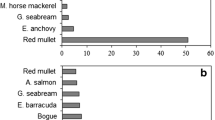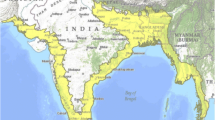Abstract
Human health risks associated with the consumption of metal-contaminated fish over extended periods have become a concern particularly in Taiwan, where fish is consumed on a large scale. This study applied the interaction-based hazard index (HI) to assess the mixture health risks for fishers and non-fishers who consume the arsenic (As), copper (Cu), and zinc (Zn) contaminated milkfish from As-contaminated coastal areas in Taiwan, taking into account joint toxic actions and potential toxic interactions. We showed that the interactions of As–Zn and Cu–Zn were antagonistic, whereas As–Cu interaction was additive. We found that HI estimates without interactions considered were 1.3–1.6 times higher than interactive HIs. Probability distributions of HI estimates for non-fishers were less than 1, whereas all 97.5%-tile HI estimates for fishers were >1. Analytical results revealed that the level of inorganic As in milkfish was the main contributor to HIs, indicating a health risk posed to consumers of fish farmed in As-contaminated areas. However, we found that Zn supplementation could significantly decrease As-induced risk of hematological effect by activating a Zn-dependent enzyme. In order to improve the accuracy of health risk due to exposure to multiple metals, further toxicological data, regular environmental monitoring, dietary survey, and refinement approaches for interactive risk assessment are warranted.





Similar content being viewed by others
References
Ademuyiwa O, Elsenhans B, Nguyen PT, Forth W (1996) Arsenic-copper interaction in the kidney of the rat: influence of arsenic metabolites. Pharmacol Toxicol 78:154–160
Antonio Garcia MT, Herrera Dueñas A, Pineda Pampliega J (2013) Hematological effects of arsenic in rats after subchronical exposure during pregnancy and lactation: the protective role of antioxidants. Exp Toxicol Pathol 65:609–614
ATSDR (Agency for Toxic Substances and Disease Registry) (2004a) Interaction profile for: lead, manganese, zinc, and copper. U.S. Department of Health and Human Services, Public Health Service, Atlanta, GA
ATSDR (Agency for Toxic Substances and Disease Registry) (2004b) Guidance manual for the assessment of joint toxic action of chemical mixtures. U.S. Department of Health and Human Services, Public Health Service, Atlanta, GA
ATSDR (Agency for Toxic Substances and Disease Registry) (2004c) Interaction profile for: arsenic, cadmium, chromium, and lead. U.S. Department of Health and Human Services, Public Health Service, Atlanta, GA
ATSDR (Agency for Toxic Substances and Disease Registry) (2016) Minimal Risk Levels (MRLs) list, March 2016. http://www.atsdr.cdc.gov/mrls/pdfs/atsdr_mrls.pdf
Cao H, Zhu H, Jia Y, Chen J, Zhang H, Qiao L (2011) Heavy metals in food crops and the associated potential for combined health risk due to interactions between metals. Hum Ecol Risk Assess 17:700–711
Chakrabarty N (2015) Arsenic toxicity: prevention and treatment. CRC Press, Boca Raton
Chan S, Gerson B, Subramaniam S (1998) The role of copper, molybdenum, selenium, and zinc in nutrition and health. Clin Lab Med 18:673–685
Chen CJ, Chen CW, Wu MM, Kuo TL (1992) Cancer potential in liver, lung, bladder and kidney due to ingested inorganic arsenic in drinking water. Br J Cancer 66:888–892
Chen CJ, Chuang YC, Lin TM, Wu HY (1985) Malignant neoplasms among residents of a blackfoot diseases-endemic area in Taiwan: high arsenic-artesian well water and cancers. Cancer Res 45:5895–5899
Chen CM, Lee SZ, Wang JS (2000) Metal contents of fish from culture ponds near scrap metal reclamation facilities. Chemosphere 40:65–69
Chien LC, Hung TC, Choang KY, Yeh CY, Meng PJ, Shieh MJ et al (2002) Daily intake of TBT, Cu, Zn, Cd and As for fishermen in Taiwan. Sci Total Environ 285:177–185
Chou BY, Liao CM, Lin MC, Cheng HH (2006) Toxicokinetics/toxicodynamics of arsenic for farmed juvenile milkfish Chanos chanos and human consumption risk in BFD-endemic area of Taiwan. Environ Int 32:545–553
Chou S, Colman J, Tylenda C, De Rosa C (2007) Chemical-specific health consultation for chromated copper arsenate chemical mixture: port of Djibouti. Toxicol Ind Health 23:183–208
Cui X, Okayasu R (2008) Arsenic accumulation, elimination, and interaction with copper, zinc and manganese in liver and kidney of rats. Food Chem Toxicol 46:3646–3650
EFSA (European Food Safety Authority) (2009) EFSA Panel on Contaminants in the Food Chain (CONTAM); scientific opinion on arsenic in food. EFSA J 7:1351
EFSA (European Food Safety Authority) (2013) International framework dealing with human risk assessment of combined exposure to multiple chemicals. EFSA J 11:3313
Elsenhans B, Schmolke G, Kolb K, Stokes J, Forth W (1987) Metal-metal interactions among dietary toxic and essential trace metals in the rat. Ecotoxicol Environ Saf 14:275–287
FACOA (Fisheries Agency, Council of Agriculture, Executive Yuan, Taiwan, R.O.C.) (2014) Fisheries Statistical Yearbook 2014 (in Chinese). https://www.fa.gov.tw/cht/PublicationsFishYear/
Flora SJ, Chouhan S, Kannan GM, Mittal M, Swarnkar H (2008) Combined administration of taurine and monoisoamyl DMSA protects arsenic induced oxidative injury in rats. Oxidative Med Cell Longev 1:39–45
Ganger R, Garla R, Mohanty BP, Bansal MP, Garg ML (2016) Protective effects of zinc against acute arsenic toxicity by regulating antioxidant defense system and cumulative metallothionein expression. Biol Trace Elem Res 169:218–229
Giri S, Singh AK (2014) Assessment of human health risk for heavy metals in fish and shrimp collected from Subarnarekha river, India. Int J Environ Health Res 24:429–449
Gürer H, Ozgünes H, Neal R, Spitz DR, Erçal N (1998) Antioxidant effects of N-acetylcysteine and succimer in red blood cells from lead-exposed rats. Toxicology 128:181–189
Han BC, Jeng WL, Chen RY, Fang GY, Hung TC, Tseng RJ (1998) Estimation of target hazard quotients and potential health risks for metals by consumption of seafood in Taiwan. Arch Environ Contam Toxicol 35:711–720
Howard G (2003) Arsenic drinking-water and health risk: substitution in arsenic mitigation: a discussion paper. World Health Organization, Geneva
Hunder G, Schaper J, Ademuyiwa O, Elsenhans B (1999) Species differences in arsenic-mediated renal copper accumulation: a comparison between rats, mice and guinea pigs. Hum Exp Toxicol 18:699–705
Jang CS, Liu CW, Lin KH, Huang FM, Wang SW (2006) Spatial analysis of potential carcinogenic risks associated with ingesting arsenic in aquacultural tilapia (Oreochromis mossambicus) in blackfoot disease hyperendemic areas. Environ Sci Technol 40:1707–1713
JECFA (Joint FAO/WHO Expert Committee on Food Additives) (2014) Evaluations of the Joint FAO/WHO Expert Committee on Food Additives (JECFA), includes all updates up to the 79th JECFA (June 2014). http://apps.who.int/food-additives-contaminants-jecfa-database/search.aspx
Krishnan K, Brodeur J (1994) Toxic interactions among environmental pollutants: corroborating laboratory observations with human experience. Environ Health Perspect 102:11–17
Kuo TL (1968) Arsenic content of arsenic well water in endemic area of chronic arsenic poisoning. Rep Inst Pathol Natl Taiwan Univ 19:7–13
Liang CP, Jang CS, Chen JS, Wang SW, Lee JJ, Liu CW (2013) Probabilistic health risk assessment for ingestion of seafood farmed in arsenic contaminated groundwater in Taiwan. Environ Geochem Health 35:455–464
Liang CP, Liu CW, Jang CS, Wang SW, Lee JJ (2011) Assessing and managing the health risk due to ingestion of inorganic arsenic from fish and shellfish farmed in blackfoot disease areas for general Taiwanese. J Hazard Mater 186:622–628
Liang CP, Jang CS, Liu CW, Lin KH, Lin MC (2010) An integrated GIS-based approach in assessing carcinogenic risks via food-chain exposure in arsenic-affected groundwater areas. Environ Toxicol 25:113–123
Lin MC (2009) Risk assessment on mixture toxicity of arsenic, zinc and copper intake from consumption of milkfish, Chanos chanos (Forsskål), cultured using contaminated groundwater in Southwest Taiwan. Bull Environ Contam Toxicol 83:125–129
Lin MC, Liao CM (1999) 65Zn(II) accumulation in the soft tissue and shell of abalone Haliotis diversicolor supertexta via the alga Gracilaria tenuistipitata var. liui and the ambient water. Aquaculture 178:89–101
Lin MC, Liao CM (2008) Assessing the risks on human health associated with inorganic arsenic intake from groundwater-cultured milkfish in southwestern Taiwan. Food Chem Toxicol 46:701–709
Lin MC, Liao CM, Liu CW, Singh S (2001) Bioaccumulation of arsenic in aquacultural large-scale mullet Liza macrolepis from blackfoot disease area in Taiwan. Bull Environ Contam Toxicol 67:91–97
Ling MP, Wu CC, Yang KR, Hsu HT (2013) Differential accumulation of trace elements in ventral and dorsal muscle tissues in tilapia and milkfish with different feeding habits from the same cultured fishery pond. Ecotoxicol Environ Saf 89:222–230
Ling MP, Wu CH, Chen SC, Chen WY, Chio CP, Cheng YH (2014) Probabilistic framework for assessing the arsenic exposure risk from cooked fish consumption. Environ Geochem Health 36:1115–1128
Liu CW, Huang FM, Hsueh YM (2005) Revised cancer risk assessment of inorganic arsenic upon consumption of tilapia (Oreochomis mossambicus) from blackfoot disease hyperendemic areas. Bull Environ Contam Toxicol 74:1037–1044
Modi M, Kaul RK, Kannan GM, Flora SJ (2006) Co-administration of zinc and n-acetylcysteine prevents arsenic-induced tissue oxidative stress in male rats. J Trace Elem Med Biol 20:197–204
Modi M, Pathak U, Kalia K, Flora SJ (2005) Arsenic antagonism studies with monoisoamyl DMSA and zinc in male mice. Environ Toxicol Pharmacol 19:131–138
Mumtaz MM, Poirier KA, Coleman JT (1997) Risk assessment for chemical mixtures: fine-tuning the hazard index approach. J Clean Technol Environ Toxicol Occup Med 6:189–204
NHRI (National Health Research Institutes, Taiwan) (2005) National Health Interview Survey 2005 (in Chinese). http://nhis.nhri.org.tw/2005download.html
Pohl HR, McClure P, Rosa CT (2004) Persistent chemicals found in breast milk and their possible interactions. Environ Toxicol Pharmacol 18:259–266
Pohl HR, Roney N, Wilbur S, Hansen H, De Rosa CT (2003) Six interaction profiles for simple mixtures. Chemosphere 53:183–197
Ragas AM, Oldenkamp R, Preeker NL, Wernicke J, Schlink U (2011) Cumulative risk assessment of chemical exposures in urban environments. Environ Int 37:872–881
Raknuzzaman M, Ahmed MK, Islam MS, Habibullah-Al-Mamun M, Tokumura M, Sekine M, Masunaga S (2016) Trace metal contamination in commercial fish and crustaceans collected from coastal area of Bangladesh and health risk assessment. Environ Sci Pollut Res Int 23:17298–17310
Ryker SJ, Small MJ (2008) Combining occurrence and toxicity information to identify priorities for drinking-water mixture research. Risk Anal 28:653–666
Tsai JW, Ju YR, Huang YH, Deng YS, Chen WY, Wu CC et al (2013) Toxicokinetics of tilapia following high exposure to waterborne and dietary copper and implications for coping mechanisms. Environ Sci Pollut Res 20:3771–3780
Tseng CH, Tai TY, Chong CK, Tseng CP, Lai MS, Lin BJ et al (2000) Long-term arsenic exposure and incidence of non-insulin-dependent diabetes mellitus: a cohort study in arseniasis-hyperendemic villages Taiwan. Environ Health Perspect 108:847–851
Tseng WP, Chu HM, How SW, Fong JM, Lin CS, Yeh S (1968) Prevalence of skin cancer in an endemic area of chronic arsenicism in Taiwan. J Natl Cancer Inst 40:453–463
USEPA (United States Environmental Protection Agency) (1991) Risk assessment guidance for superfund volume I: human health evaluation manual, supplemental guidance “standard default exposure factors”. Office of Emergency and Remedial Response, Washington, DC
USEPA (United States Environmental Protection Agency) (2000) Supplementary guidance for conducting health risk assessment of chemical mixtures. U.S. Environmental Protection Agency, Risk Assessment Forum, Washington, DC
USEPA (United States Environmental Protection Agency) (2016) Regional Screening Level (RSL) summary table (TR = 1E-06, HQ = 1), May 2016. https://www.epa.gov/risk/regional-screening-levels-rsls-generic-tables-may-2016
Uthus EO (2001) High dietary arsenic exacerbates copper deprivation in rats. J Trace Elem Exp Med 14:43–55
Yi Y, Yang Z, Zhang S (2011) Ecological risk assessment of heavy metals in sediment and human health risk assessment of heavy metals in fishes in the middle and lower reaches of the Yangtze River basin. Environ Pollut 159:2575–2585
Acknowledgements
This work was supported by the Ministry of Science and Technology of the Republic of China under Grant MOST 103-2221-E-039-003.
Author information
Authors and Affiliations
Corresponding authors
Ethics declarations
Conflict of interest
The authors declare that they have no competing interests.
Research involving human participants and animal rights
The article does not contain any studies with human participants or animals performed by any of the authors.
Additional information
Responsible editor: Philippe Garrigues
Electronic supplementary material
ESM 1
(DOCX 22 kb)
Rights and permissions
About this article
Cite this article
Lin, YJ., Ling, MP., Chen, SC. et al. Mixture risk assessment due to ingestion of arsenic, copper, and zinc from milkfish farmed in contaminated coastal areas. Environ Sci Pollut Res 24, 14616–14626 (2017). https://doi.org/10.1007/s11356-017-8982-9
Received:
Accepted:
Published:
Issue Date:
DOI: https://doi.org/10.1007/s11356-017-8982-9




